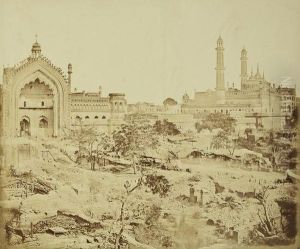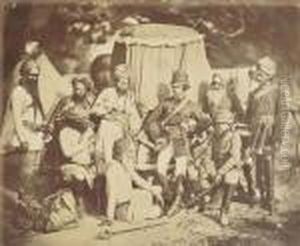Felice Beato Paintings
Felice Beato, a pioneering figure in the history of photography, was born in 1832 in Venice, Italy, but his career and travels would mark him as one of the first photographers to document the landscapes, cultures, and conflicts of Asia and the Middle East. His work is significant for its early contribution to the field of photojournalism and for the breadth of his geographical coverage during a time when photography was still in its infancy. Beato is often associated with the second wave of Orientalist photography, which sought to capture and sometimes stage the exoticism of the East for Western audiences.
Beato's career in photography began in the 1850s, and his early work included coverage of the Crimean War in 1855, where he worked alongside British photographer James Robertson. This partnership was significant, as it marked one of the earliest examples of war photography. Following the Crimean War, Beato expanded his geographical scope, traveling extensively through the Ottoman Empire, India, China, and Japan. His photographs from the Second Opium War (1856-1860) in China, including the aftermath of the Taku Forts and the Summer Palace in Beijing, are particularly notable for their historical value and their stark portrayal of the effects of war.
Beato's time in Japan, from 1863 to 1884, represents one of the most fruitful periods of his career. He captured a wide array of subjects, from landscapes and cityscapes to portraits of Japanese people, including samurai and geisha, at a time when Japan was transitioning from feudal isolation to a more modern state. His work during this period is invaluable for its documentation of a pivotal moment in Japanese history. Beato's photographs are characterized by their compositional skill and often innovative use of hand-coloring, a technique that added vibrancy and realism to his images.
Despite his contributions to photography and his extensive travels, details about Beato's personal life remain somewhat elusive, contributing to the mystique surrounding his character. After leaving Japan, he continued to travel and work in other parts of the world, including Burma (Myanmar), where he documented the Anglo-Burmese Wars. Beato eventually settled in Burma, where he continued to work until his death in 1909.
Felice Beato's legacy lies in his pioneering role in the development of photojournalism and his efforts to document the world through his lens. His work provides a valuable visual record of 19th-century Asia and the Middle East, offering insight into the cultures, landscapes, and historical events of the period. Beato's photographs not only captivated the Western audiences of his time but continue to be celebrated for their historical significance and artistic merit.

